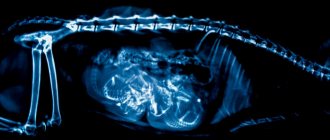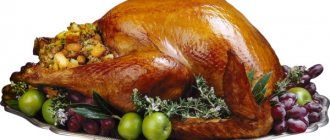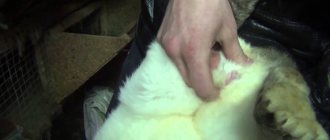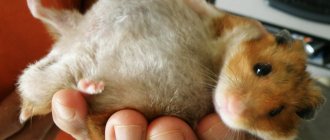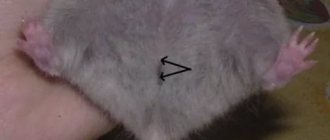How to determine pregnancy in a hamster?
It must be said that if the moment of mating was not noticed, then it is unlikely that it will be possible to immediately determine whether the female is pregnant. This can only be assumed by changed behavior. The following signs are possible:
- increased excitability and aggressiveness or, conversely, complete calm and relaxation;
- collecting materials for the nest;
- increased appetite.
The most obvious indicator is an enlarged abdomen, but if this becomes noticeable, it means that labor is coming soon. You can also determine pregnancy by the cessation of estrus and swollen nipples.
Photo of a pregnant Syrian hamster
Establishing pregnancy
So, we found out at what age a female is able to become pregnant and how long this period lasts. Now let's find out how to understand that a female hamster is pregnant.
- The first sign is a uniformly rounded belly. But it can only be distinguished from the 10th day of pregnancy.
- The second sign is the sudden and pronounced appearance of the nipples. Typically, a female hamster's nipples are light and pale. During pregnancy, they become bright pink and stand out against the background of the fur.
- The third sign is an increase in appetite. The expectant mother eats everything in her bowl with the energy of a vacuum cleaner. And he looks through the bars of the cage at the owner, waiting for more.
- The fourth sign is a change in behavior. An affectionate and tame girl becomes a real fury. When trying to pick her up, he uses his teeth.
- The fifth sign is nest building. The future hamster mother begins to fuss and build herself a nest from scrap materials.
If the owner notices these signs in his pet, the pet store will sell him a lady with a “surprise”.
How long does a hamster's pregnancy last?
For different species of hamsters, the gestation period varies quite significantly. Gestation period in days:
- Syriac – 16 – 18;
- Dzungarian, Chinese, Campbell - 18 - 21;
- Roborovsky – 23 – 30.
If you carefully examine Syrian hamsters a week after mating, and Djungarian hamsters after 9 days, you can feel small fruit balls in the stomach. At the same time, the nipples swell and weight begins to gain. If this does not happen, you need to look for deficiencies either in the diet or in the pet’s health.
When can you take hamsters away from their mother?
Hamsters are born absolutely helpless: they are blind, deaf, completely hairless and red; for minimal orientation in space and finding the mother, the babies have a slightly developed sense of smell. In general, they are completely dependent on their mother and are very vulnerable - little hamsters will not survive without their mother until they are 10 days old!
Some development features:
- on the 5th day the first fur appears;
- at the age of a week, babies begin to try solid food;
- on the 14th day the eyes begin to open;
- On days 20–21, lactation ends completely and the babies switch to independent feeding.
Did you know? At birth, the weight of a baby hamster does not exceed 2 g, and its size is only 10
–
15 mm!
Around this time, they can be taken from their mother and placed in separate cages. The maximum period until which animals can be kept together is 5 weeks. Keeping pets together for longer is very dangerous, since by nature they are loners and are very jealous of their territory.
Thus, the appearance of offspring in hamsters is a rather exciting, but extremely responsible process. You should not allow pets to reproduce at random, because pregnancy and childbirth are a difficult task for females. Therefore, the birth of small hamsters must be approached responsibly, the intervals between pregnancies must be observed, the female must be given the opportunity to fully recover and the most appropriately provided comfortable conditions for the pet so that the life of her and the babies is safe!
Does pregnancy differ between species?
In the table we note what behavioral features are characteristic of different hamsters.
| Aggression towards the male | Nesting behavior | |
| Syrian | It appears brightly, the female can injure or even kill the male, after mating it is necessary to place them in different cages | Very pronounced |
| Dzungarian | Maybe, but sometimes absent (manifests individually), it is recommended to separate | Characteristic |
| Campbell | The male can be with the female and even participate in raising the offspring | Present |
What conditions need to be created for successful reproduction?
To encourage hamsters to mate after uniting them under one roof, you should place a lamp in the immediate vicinity of the cage and direct the light from it into the cage. In this case, the animals will look for a dark corner in their home. This will certainly bring them closer.
The best option for mating would be a separate cage, carrier, or box . This way you can avoid conflict. If this is not possible, then the female is placed with the male, and not vice versa.
The mating cage should be spacious. The room temperature is not lower than 20°C and not higher than 25°C. The cage should be installed in a secluded place where there are no drafts, noise, heating devices, and away from other pets. It is advisable to remove all gaming accessories from it.
Find out more about hamsters: what breed of pet hamster to choose, how long do hamsters of different breeds live, how to train a hamster to respond to its name.
Do not abandon animals immediately after joining without supervision. If a serious fight breaks out, they will need to be seated. You can leave them alone only if it is clear that they like each other.
Since after conception the female will begin to build a nest, she needs to put materials in the cage - rags, cotton wool, clean paper, hay. Placing newspapers in the cage is strictly prohibited.
Do false pregnancies occur in hamsters?
A situation is possible when all the signs are present, but labor does not occur. In this case, we can talk about a false pregnancy. This happens to hamsters. In addition, under the influence of stressful situations, the formed embryos can simply dissolve. If such failures occur in pets, it is better to consult a veterinarian.
Pregnant Djungarian hamster
Caring for a pregnant hamster
First of all, the female needs rest during this period. As soon as it is determined that pregnancy has indeed occurred, you need to move the cage to a quiet place. It is better to replace the usual housing with a sufficiently voluminous glass container to prevent the babies from falling out through the bars in the future. It is necessary to provide the hamster with material for building a nest; this can be paper napkins without dyes.
The house must be cleaned regularly and even more thoroughly than usual, since during this period the female diligently stores food, which can spoil.
Adult Djungarian hamster
You should pick up your pet carefully and only if absolutely necessary. At the same time, you should take care to protect your hands (for example, with gloves), otherwise the hamster may scratch or bite.
Approximately 4 days before giving birth, all contact with the animal should be stopped.
Preparing the cell for birth
If the owner is sure that his pet is expecting an addition, it is necessary to take care in advance about where and how the female will give birth. Maternity hospitals for hamsters have not yet been invented, and the owner will have to organize it himself.
There is nothing complicated about it. All you need is:
- The cage is one-story with a retractable bottom.
- Soft sawdust that will fill the bottom.
- Clean rags - they will serve as a nest for the expectant mother.
- Feeder and drinker. They can be removed from the old cage after washing them thoroughly.
The cage must be cleaned. First you need to treat not only the bottom, but also the top with laundry soap. Then rinse off the soap thoroughly and scald the cage with boiling water. After which it is placed on a towel and allowed to drain. Remaining moisture is removed with paper towels. Wait until the cell is completely dry.
Now it can be installed in a warm place where there are no drafts and no one can disturb the female in labor. A thick layer of sawdust is poured onto the bottom of the cage. Rags for the nest are also placed here. You can put up a wooden house in which the mother will hide from prying eyes.
They put up a feeder and hang up a drinking bowl. Pre-wash them in the same way as the cage.
Nutritional features of a pregnant hamster
In order for the female to bear and raise healthy young without being harmed, her diet must be supplemented with calcium, protein foods and vitamins. The following products should be included in the menu:
- chicken meat;
- low-fat cottage cheese;
- eggs;
- vegetables (beets, carrots);
- sprouted cereal seeds;
- greens, juicy herbs.
Of the first three listed components, one should be in the diet daily. You need to be careful with green and succulent foods so as not to cause diarrhea in your pet, but they must be included.
Little hamsters
The lack of calcium can be compensated for by adding a tablet containing this element, or simply crushed chalk, to drinking water. The same can be done with ascorbic acid.
It is better not to give perishable foods in large quantities, as the female can hide them, and this will further contribute to the development of various infections.
Tips for creating a diet for a pregnant female
Pregnant females have very different nutritional needs from normal females. Record short periods of fetal development lead to exhaustion of the mother’s body. The diet should consist of high-calorie food, which at the same time is easily digestible, providing the female with useful vitamins and microelements.
Juicy food is a storehouse of benefits for a hamster
Carrots, pumpkin and zucchini are allowed. You need to give your pet a piece of it every day. You can diversify your diet with dill or other dried herbs. Sprouts of wheat and oat seeds are useful. Vegetables should ideally be from your own garden or at least with a minimum content of harmful substances: it is better to buy them at the market rather than in the supermarket. Before serving, any product must be washed and peeled.
Apples and pears should be excluded from the diet.
Protein food is the basis of a pregnant female’s diet
Protein is essential for the hamster to develop normally. Permitted products include:
- boiled rabbit, chicken or beef without salt;
- baby meat puree from beef or turkey;
- quail or chicken boiled egg;
- low-fat dairy products without chemical additives and dyes with a fat content of no more than 1%.
Dry food is a necessary source of energy
This type of product will provide the animal with additional energy, which is vital for bearing fruit. The main requirement is high quality food, and it can be safely given to an animal in unlimited quantities. It is worth remembering that pregnant animals eat almost 3 times more than usual. A double portion will be needed after a week after mating.
Water - what is important to know?
Many people are concerned about their pet drinking too much during pregnancy, but this is a completely normal occurrence. It is necessary to change the water daily and ensure that the hamster always has it available. To improve the vitamin balance, you can add special liquid supplements for pregnant rodents.
Solo content or in company
Campbell's hamsters get along well together. Sometimes the female and male jungariki are loyal to each other. But this is rather an exception to the rule. Fighting for territory is more typical for these rodents, so it is better to keep them separately, placing the female with the male only during mating. Even a Campbell's hamster will do better alone before giving birth.
Don't handle small hamsters with your bare hands
How many times a year do hamsters give birth?
In nature, a hamster gives birth to about 4 litters per year. Rodents living in their natural environment reproduce only in the warm season. Pets are always in favorable conditions, so they can give birth more often.
The hamster is ready to breed the very next day after giving birth. If the male is nearby, mating will occur and she will become pregnant again. However, frequent childbirth greatly depletes the female’s body. Therefore, rodentologists recommend keeping individuals of different sexes separately.
According to experts, the minimum interval between births should be 2.5-3 months.
How does childbirth proceed?
Hamsters usually do not require assistance during childbirth. The only exception is when the time of mating is known exactly and the hamster is already “overcoming” her term, then it makes sense to contact a veterinarian. Moreover, for about 4 weeks after the birth of the offspring, there is no need to disturb the female, just carefully add water and food. Even cleaning should not be done for 8 days, and then carry it out carefully, without touching the nest.
During normal labor, labor lasts about 3 hours; if it lasts up to 6, this is still within normal limits. The hamsters appear at intervals of approximately 5 minutes, completely without hair, with their eyes and ears closed. The female gnaws the umbilical cord and eats it along with the amniotic sac of each baby. When the offspring are numerous, the mother may not have time to cope, then some of the hamsters die.
All hamsters are born blind
If it is a Syrian hamster, it is absolutely forbidden to interfere. For the first two days, it is not even recommended to remove dead hamsters. You can try to help the baby dwarf, take it (not with your bare hands) on a napkin, free it from the bubble and gently massage it. Then you need to return it to its mother and see if she accepts this hamster. If the female refuses to feed, you will have to feed him artificially.
A female hamster can give birth to from 4 to 12 babies (there are known cases of the birth of 18 hamsters), but she, as a rule, eats sick and non-viable ones. A hamster eats or refuses to feed its offspring in several cases:
- if you feel weak or unhealthy (with an unbalanced diet);
- when she was disturbed (due to stress);
- if he senses a foreign smell on the cubs.
After 4-5 weeks, the hamsters become adults and need to be placed in separate housing; only females can be left with their mother longer.
Complications during childbirth
How long it takes for hamsters to give birth is clear: they are able to do this monthly. But there is no point in experimenting. The female is a living being, not a birthing machine.
By the way, about the latter. During the process, complications may arise that the owner should be aware of. He is not always able to help: there are difficulties that cannot be helped.
For example, toxicosis. If it begins before childbirth, it will end in the death of the babies and the mother herself. The offspring runs the risk of dying before they are born. If the babies die inside the womb, the female will not be able to give birth. We'll have to do an emergency caesarean section.
The same goes for prolonged labor. When the female is over a year old, you should not breed her. The pelvic bones are no longer as elastic as before. And the animal is not able to give birth on its own.
Mastitis occurs in lactating individuals. The temperature rises and the mammary glands become inflamed. The female cannot feed the babies due to pain.
Endometritis is a very dangerous thing. This is an inflammation of the uterus, accompanied by bloody discharge. Normally, blood can “leak” for three days. But if the process is delayed, and the discharge acquires an unpleasant odor, this indicates endometritis. Veterinary assistance is required.
Nutrition for hamsters and female hamsters after birth
The female's diet after childbirth should remain enhanced, since a lot of energy is spent on lactation. Even with such nutrition, the hamster loses up to 25% of its weight during this period. All products that were given to the animal during pregnancy remain on the menu. It is also necessary to monitor the drinking regime in order to produce a sufficient amount of milk; the female needs a lot of liquid.
Newborn hamsters eat baby food
Small hamsters, when they stand on their legs, become very active, and they also require a large amount of calories. Solid foods are introduced gradually; canned food for children can be used. Among cereals, imported small grain mixtures are best suited.
If you follow all the necessary recommendations, you can get healthy offspring from one female 3-4 times during her life. The most suitable age for a hamster to give birth is from 3 to 12 months.
Great article 19
How to care for a female?
It's clear how hamsters give birth. Baby hamsters should not be touched. What to do with a young mother? How to care for her?
First of all, the female needs peace and comfort. Don't bother her. It is advisable to place the cage so as not to disturb the pet with your presence again.
The only thing the owner can do to help his ward is the correct diet. For a nursing female, the menu is completely changed. More precisely, they are expanding. Its basis is food for hamsters, but there are many additions.
A young mother needs vitamins. She gets them from fruits and berries. Apples, pears, apricots, peaches, strawberries, raspberries and other goodies should be present in her diet according to the season.
We must not forget about vegetables. Zucchini, cucumbers, tomatoes, cabbage, and pumpkin will be an excellent addition to the female’s diet.
A young mother will not refuse greens either. Dill, parsley, lettuce - in the cold season. When it's warm, dandelion leaves and nettles are suitable.
Three times a week, give boiled chicken breast without salt and spices. A hard-boiled egg is a must on the menu. Low-fat cottage cheese and kefir will bring great benefits to your pet.
And most importantly, the usual portion of dry food should be doubled. The process of lactation and childbirth itself wears out the pet’s body. She loses a lot of weight, and if her nutrition is poor, she is able to eat her own cubs.





